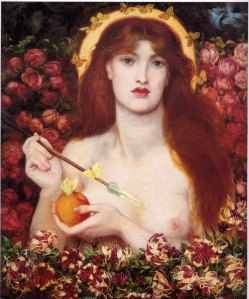Venus Verticordia, an oil on canvas painting by Dante Gabriel Rossetti (1828-1882) that stands at 83.3 x 71.2cm currently resides in the Russell-Coates Art Gallery and Museum. Originally commissioned by John Mitchell, a textile merchant of Bradford, in 1863-4 it was finished in 1868 having undergone considerable changes to initial sketches. The final, finished painting reveals a nude Venus with the entirety of the space around her utilised through the depiction of red stained honeysuckles and roses that encircle and shroud the figure. She holds an apple in her left hand, a dart in the other and her flowing hair is topped with a golden halo, wreathed in butterflies.
When first looking at the image, the first thing of note is her gaze; she looks directly out of the frame to the (male) viewer with her haughty appraisal, which is in keeping with her role as the Goddess of Love; the temptress.[1] And yet this gaze is also frozen and unnatural, set within the unrealistic physiognomy typical of the Alexa Wilding portraits that begin to be seen in Rossetti’s work from around 1866. This ‘particular cast of beauty [seen almost obsessively] again and again’[2], includes a forehead that is unnaturally small, resulting in the elongation of the eye to chin area. This being said, her face type was also seen to be more ‘ideal’ however unattainably unnatural it may be. [3] This concept of the female paragon is one that, through existence, points towards the author: male desire; the male is in the position of the creator and, in turn, becomes the voyeur of the female form.
The desire of the creator mirrors the narrative of Pygmalion; J. B. Bullen goes as far as to call it ‘the Pygmalion syndrome’,[4] which draws on the idea of creating something for the purpose of possession. This is emphasised by certain facts of its creation such as the fact that this depiction of Venus was created for a private commission and that the model for an initial sketch from 1863 was a working-class woman who used to work in the Rossetti household. This is important as it bypasses the Victorian angel/whore dichotomy, reconciling the problem of seeing a middle-class woman as both a lady of society and as a sexualised object. [5] Furthermore, Rossetti has taken the image out of any discernible context; it belongs neither to any specific time or place, the object of desire is separated from any reality known to the onlooker meaning that ‘the painted image of the loved one is that which can be utterly and timelessly possessed.’[6] However, this possession is not just one that relies on the ideal of the female form but also its sexualisation. This can be further seen through the use of flowing red hair and the use of the language of flowers in the image, which were typically used as a ‘decent and suggestive sign of allowed disorder, conventionally a sign of woman’s sexuality’.[7]
This possession of the woman is tempered, however, by a warning in the poem in the top right of this initial Venus Verticordia sketch that reads: ‘Alas! the apple for his lips, – the dart that follows its brief sweetness to his heart’. Here, Rossetti uses the Apple of Discord to demonstrate the repercussions of straying into Venus’ embrace[8] and the dart, which suggests ‘a female appropriation of male sexuality, which is then turned back upon the viewer’[9]. As Griselda Pollock argues, there is the introduction of death into the field of love[10] by making the subject a kind of shrine to female beauty but also, running adjacent to this, is the metaphorical death of the viewer.[11]
The idea of desire is created through presenting the paragon of femininity. This has been done by using the Alexa Wilding face type and offsetting this with generally accepted modes of pictorial depiction such as flowers and flowing hair that create the concept of an ideal that is sexualised, the possession of which becomes allowable by using a lower-class woman as a model, thus bypassing the angel/whore dichotomy. However, with this ‘excitation of desire in the viewer by sensual imagery such as flowers or an exposed breast, [there is the] simultaneous blockage of that desire by the threat of death if desire is ever consummated’.[12]
[1] Jennifer J. Lee. Venus Imaginaria: Reflections on Alexa Wilding, her Life, and her Role and Muse in the Works of Dante Gabriel Rossetti. (M.A. diss University of Maryland 2006) p.25
[2] Sidney Colvin, “Rossetti as a Painter”. Magazine of Art 6 (1883) p.183
[3] Prettejohn, Elizabeth (ed). After the pre-Raphaelites: Art and Aestheticism in Victorian England. (Manchester: Manchester University Press, 1999) p.27
[4] J. B. Bullen. The pre-Raphaelite Body: Fear and Desire in Painting, Poetry and Criticism. (Oxford: Clarendon Press, 1998) p.110
[5] Martin A. Danahay. “Mirrors of Masculine Desire: Narcissus and Pygmalion in Victorian Representation”. Victorian Poetry. vol 32, no 1 (1994) p.44-46
[6] Griselda Pollock. Vision and Difference: Feminism, Femininity and the Histories of Art. (London: Routledge, 2003) p.185-6
[7] Griselda Pollock. Vision and Difference p.184
[8] Elizabeth Prettejohn. After the pre-Raphaelites p.27
[9] Martin A. Danahay. “Mirrors of Masculine Desire”. P.44-46
[10] Griselda Pollock. Vision and Difference. p.186
[11] Martin A. Danahay. “Mirrors of Masculine Desire”. P.44
[12] Martin A. Danahay. “Mirrors of Masculine Desire”. P.44
